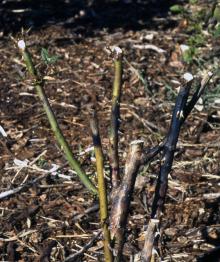See:
Rose (Rosa spp.) and hybrids - Bacterial Leaf Spot and Blast
Cause Cold and dry wind can kill the scion of a dormant rose. Plants fertilized late in the year may continue lush growth into fall and early winter and are more susceptible to winter injury. Some cultivars are not adapted to colder regions or higher elevations. Good cold hardiness was introduced in rose breeding programs through hybridization with wild species such as R. rugosa, R. arkansana and R. wichurana.
In late autumn/early winter, induced by the decline of photoperiod, light intensity, and temperature, woody plants gradually increase their cold hardiness level. In mid-winter, cold hardiness reaches its maximum level and decreases towards spring when temperature and day-length rise again. Cold hardiness includes three stages: acclimation, mid-winter hardiness, and deacclimation. Rapid temperature drops during acclimation or deacclimation can injure roses where the same drop might not injure roses during mid-winter hardiness.
Symptoms Buds may fail to break open in spring or may wilt and collapse shortly after emerging. In severe cases, canes turn black or deep purple. Rootstocks may survive and emerge at or below the ground level later than other roses. The rootstock will tend to have leggy growth, thin canes, and small, numerous flowers.
Cultural control
- Do not fertilize late in the growing season.
- Chose a cultivar adapted to your growth zone.
- After fall pruning, use a mulch that does not hold water.
- In eastern Washington, plant the graft union 2 inches below the soil surface.
Reference Ouyang, L., Leus, L., and Van Labeke, M. C. 2019. Three-year screening for cold hardiness of garden roses. Scientia Horticulturae, 245:12-18.

